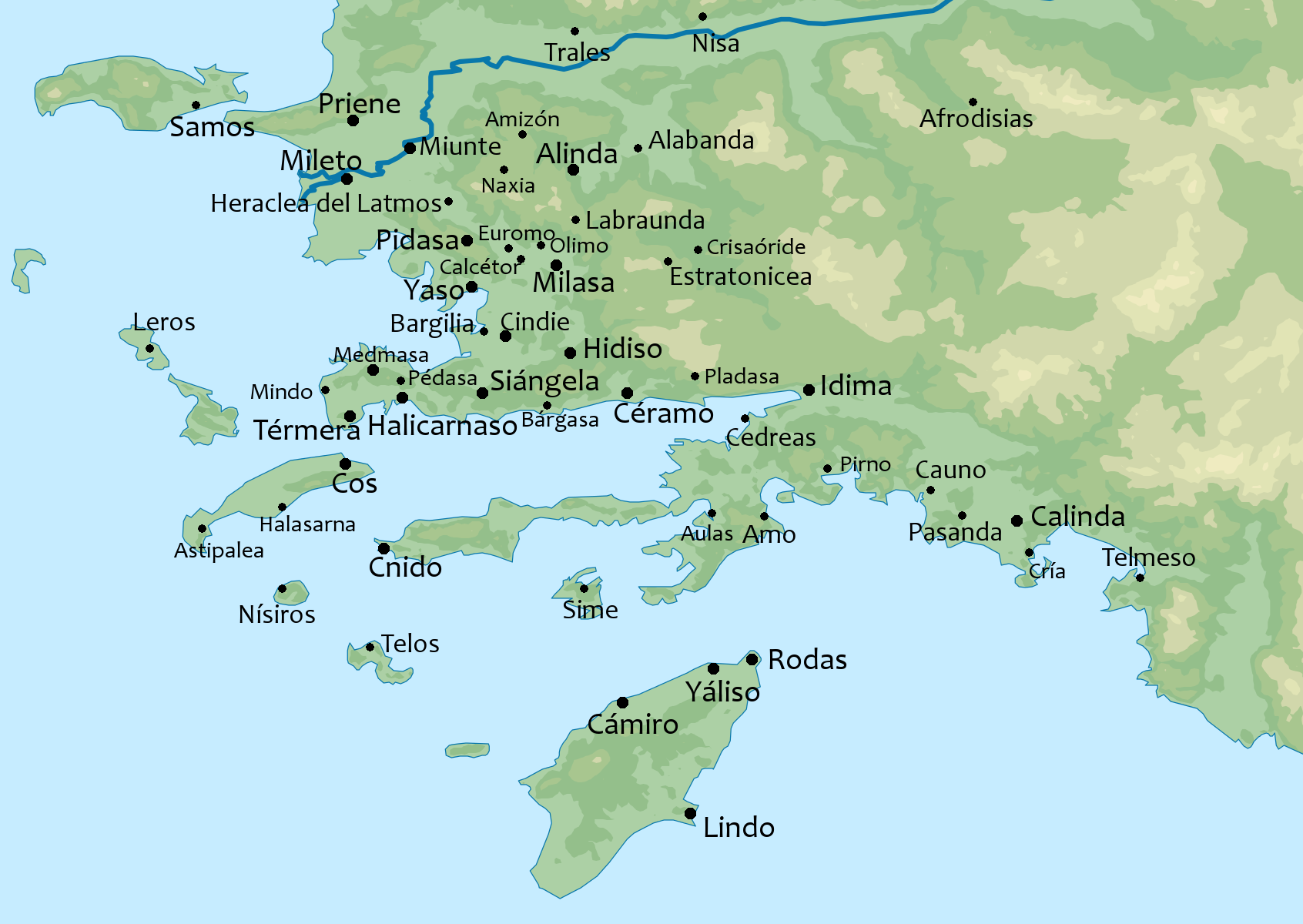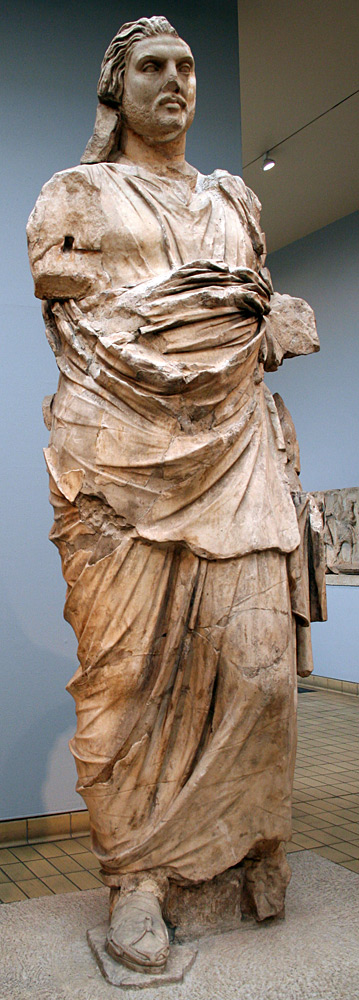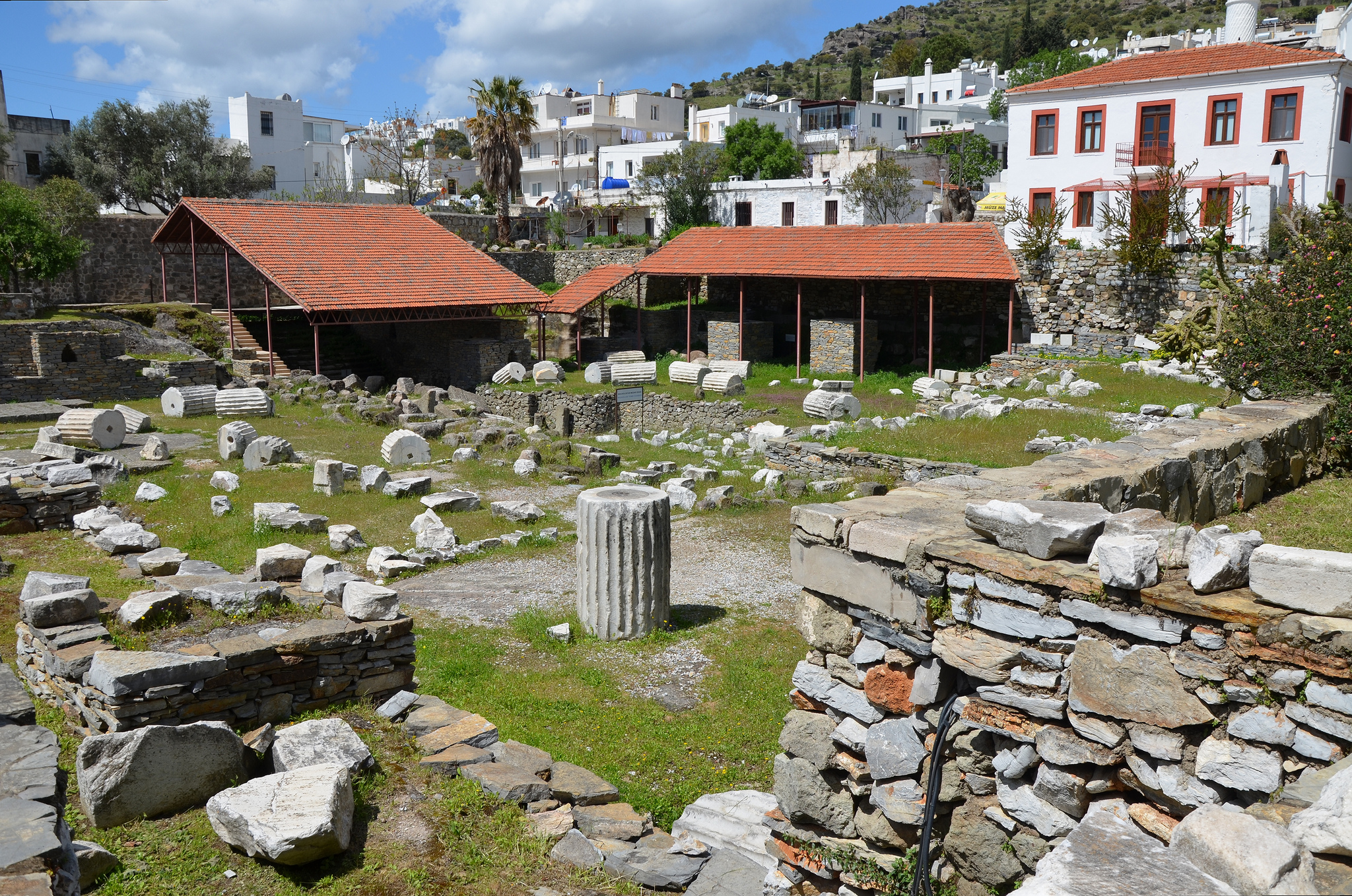|
Idrieus
Idrieus, or Hidrieus ( grc, Ἱδριεύς, Hidrieús; died 344 BC) was a ruler of Caria as a Satrap under the Achaemenid Empire. Alongside his sister and wife Ada, he enjoyed the status of king or dynast by virtue of the powerful position he inherited from his predecessors of the House of Hecatomnus (the Hecatomnids). Biography Idrieus was the second son of Hecatomnus, and was married to his sister Ada. Alongside Ada, he succeeded to the throne on the death of his sister Artemisia II of Caria in 351 BC. Shortly after his accession he was required by the Persian king, Artaxerxes III Ochus, to provide arms and troops for the capture of Cyprus, a request with which he readily complied. He equipped a fleet of 40 triremes and assembled an army of 8000 mercenary troops. These were despatched for use against Cyprus under the command of Evagoras and the Athenian general Phocion. This is the only recorded event preserved from his reign. However; it can be inferred from Isoc ... [...More Info...] [...Related Items...] OR: [Wikipedia] [Google] [Baidu] |
Ada Of Caria
Ada of Caria ( grc, Ἄδα) (fl. 377 – 326 BC)377 BC is the date of her father's death: was a member of the House of Hecatomnus (the Hecatomnids) and ruler of Caria during the mid-4th century BC, first as Persian Satrap and later as Queen under the auspices of Alexander III (the Great) of Macedon. History Ada was the daughter of Hecatomnus, satrap of Caria, sister of Mausolus, Pixodarus, Artemisia, and Idrieus.Sears, Matthew A. (2014). p.213 Four of the siblings intermarried: Mausolus wed Artemisia, while Ada was married to her brother Idrieus. Pixodarus married outside of the family. Every child of Hecatomnus would govern over Caria at some point. Mausolus and Artemisia first ruled together, and after Mausolus' death, Artemisia ruled alone until she died in 344 BC. Idrieus and Ada ruled together for four years, until his death. During their rule, they kept close ties to the Hellenic world.Sears, Matthew A. (2014). p.217 The joint regents were mentioned as donors t ... [...More Info...] [...Related Items...] OR: [Wikipedia] [Google] [Baidu] |
Labraunda
Labraunda ( grc, Λάβρανδα ''Labranda'' or Λάβραυνδα ''Labraunda'') is an ancient archaeological site five kilometers west of Ortaköy, Muğla Province, Turkey, in the mountains near the coast of Caria. In ancient times, it was held sacred by Carians and Mysians alike. The site amid its sacred plane trees was enriched in the Hellenistic style by the Hecatomnid dynasty of Mausolus, satrap (and virtual king) of Persian Caria (c. 377 – 352 BCE), and also later by his successor and brother Idrieus; Labranda was the dynasty's ancestral sacred shrine. The prosperity of a rapidly hellenised Caria occurred in the during the 4th century BCE. Remains of Hellenistic houses and streets can still be traced, and there are numerous inscriptions. The cult icon here was a local Zeus Labrandeus (Ζεὺς Λαβρανδεύς), a standing Zeus with the tall lotus-tipped scepter upright in his left hand and the double-headed axe, the ''labrys'', over his right shoulder. The cult ... [...More Info...] [...Related Items...] OR: [Wikipedia] [Google] [Baidu] |
Mausolus
Mausolus ( grc, Μαύσωλος or , xcr, ���𐊠���𐊸𐊫𐊦 ''Mauśoλ'') was a ruler of Caria (377–353 BCE) and a satrap of the Achaemenid Empire. He enjoyed the status of king or dynast by virtue of the powerful position created by his father Hecatomnus ( xcr, 𐊴𐊭𐊪𐊳𐊫 ), who had succeeded the assassinated Persian Satrap Tissaphernes as the first satrap of Caria and founded the hereditary Hecatomnid dynasty. Alongside Caria, Mausolus also ruled Lycia and parts of Ionia and the Dodecanese islands. He is best known for the monumental shrine, the Mausoleum at Halicarnassus, erected and named for him by order of his widow (who was also his sister) Artemisia. Name Mausolus' name is only known directly in Greek ( grc, Μαύσωλος or ). It is clearly of Carian origin, though, and would have been written as *𐊪𐊠𐊲𐊸𐊫𐊦 (''*Mauśoλ'') or similar. This is a compound name perhaps meaning "much blessed". The first part, ''*Ma-'', may mean ... [...More Info...] [...Related Items...] OR: [Wikipedia] [Google] [Baidu] |
Artaxerxes III
Ochus ( grc-gre, Ὦχος ), known by his dynastic name Artaxerxes III ( peo, 𐎠𐎼𐎫𐎧𐏁𐏂𐎠 ; grc-gre, Ἀρταξέρξης), was King of Kings of the Achaemenid Empire from 359/58 to 338 BC. He was the son and successor of Artaxerxes II and his mother was Stateira. Before ascending the throne Artaxerxes was a satrap and commander of his father's army. Artaxerxes came to power after one of his brothers was executed, another committed suicide, the last murdered and his father, Artaxerxes II died. Soon after becoming king, Artaxerxes murdered all of the royal family to secure his place as king. He started two major campaigns against Egypt. The first campaign failed, and was followed up by rebellions throughout the western part of his empire. During the second, Artaxerxes finally defeated Nectanebo II, the Pharaoh of Egypt, bringing the country back into the Persian fold after six decades. In Artaxerxes' later years, Philip II of Macedon's power was increasi ... [...More Info...] [...Related Items...] OR: [Wikipedia] [Google] [Baidu] |
Artemisia II Of Caria
Artemisia II of Caria (Greek: Ἀρτεμισία; died 350 BC) was a naval strategist, commander and the sister (and later spouse) and the successor of Mausolus, ruler of Caria. Mausolus was a satrap of the Achaemenid Empire, yet enjoyed the status of king or dynast of the Hecatomnid dynasty. After the death of her brother/husband, Artemisia reigned for two years, from 353 to 351 BCE. Her ascension to the throne prompted a revolt in some of the island and coastal cities under her command due to their objection to a female ruler. Her administration was conducted on the same principles as that of her husband; in particular, she supported the oligarchical party on the island of Rhodes. Because of Artemisia's grief for her brother-husband, and the extravagant and bizarre forms it took, she became to later ages "a lasting example of chaste widowhood and of the purest and rarest kind of love", in the words of Giovanni Boccaccio. In art, she was usually shown in the process of ... [...More Info...] [...Related Items...] OR: [Wikipedia] [Google] [Baidu] |
Hecatomnids
The Hecatomnid dynasty or Hecatomnids were the rulers of Caria and surrounding areas BCE. The Hecatomnids were satraps (governors) under the Achaemenid Empire, although they ruled with considerable autonomy, and established a hereditary dynasty. The first satrap of the dynasty was Hecatomnus. He was appointed as the first Carian satrap of Caria in the late 390s BCE. Previously, Caria had been governed as part of Lydia, by the satrap Tissaphernes based in Sardis. Tissaphernes was executed by Tithraustes on the orders of Artaxerxes II Memnon in 395 BCE. If Hecatomnus did not become satrap immediately upon the death of Tissaphernes, he was in office by 392 BCE, when he made war on Evagoras of Salamis on the orders of Artaxerxes II Memnon. Hecatomnus therefore became satrap of Caria BCE. He was previously one of many minor dynasts in Caria. The Hecatomnid dynasty's seat was originally Mylasa, in central Caria. Hecatomnus' father, Hyssaldomus, was also an independent dynast bas ... [...More Info...] [...Related Items...] OR: [Wikipedia] [Google] [Baidu] |
Hecatomnus
Hecatomnus of Mylasa or Hekatomnos ( el, Ἑκατόμνος, Carian: 𐊴𐊭𐊪𐊵𐊫 ''k̂tmno'' “under-son, descendant(?)”) was an early 4th-century BC ruler of Caria. He was the satrap (governor) of Caria for the Persian Achaemenid king Artaxerxes II (404–358 BC). However, the basis for Hecatomnus' political power was twofold: he was both a high appointed Persian official and a powerful local dynast, who founded the hereditary dynasty of the Hecatomnids. The Hecatomnids followed the earlier autochthonous dynasty of the Lygdamids (520-450 BC) in Caria. Biography Hecatomnus was the son and successor of Hyssaldomus, a dynastic ruler of Mylasa. It is likely that Hecatomnus had been a supporter of Tissaphernes and might have been employed by him in the subordinate office of hyparch. At some time after 395 BC Hecatomnus became the first satrap of Caria, which was until then part of other satrapies, usually that of Lydia. The designation of Caria as a separate sa ... [...More Info...] [...Related Items...] OR: [Wikipedia] [Google] [Baidu] |
Halicarnassus
Halicarnassus (; grc, Ἁλικαρνᾱσσός ''Halikarnāssós'' or ''Alikarnāssós''; tr, Halikarnas; Carian: 𐊠𐊣𐊫𐊰 𐊴𐊠𐊥𐊵𐊫𐊰 ''alos k̂arnos'') was an ancient Greek city in Caria, in Anatolia. It was located in southwest Caria, on an advantageous site on the Gulf of Gökova, which is now in Bodrum, Turkey.} The city was famous for the Mausoleum of Halicarnassus, also known simply as the Tomb of Mausolus, whose name provided the origin of the word "mausoleum". The mausoleum, built from 353 to 350 BC, ranked as one of the seven wonders of the ancient world. Halicarnassus' history was special on two interlinked issues. Halicarnassus retained a monarchical system of government at a time when most other Greek city states had long since rid themselves of their kings. And secondly, while their Ionian neighbours rebelled against Persian rule, Halicarnassus remained loyal to the Persians and formed part of the Persian Empire until Alexander the ... [...More Info...] [...Related Items...] OR: [Wikipedia] [Google] [Baidu] |
Achaemenid Empire
The Achaemenid Empire or Achaemenian Empire (; peo, 𐎧𐏁𐏂, , ), also called the First Persian Empire, was an ancient Iranian empire founded by Cyrus the Great in 550 BC. Based in Western Asia, it was contemporarily the largest empire in history, spanning a total of from the Balkans and Egypt in the west to Central Asia and the Indus Valley in the east. Around the 7th century BC, the region of Persis in the southwestern portion of the Iranian plateau was settled by the Persians. From Persis, Cyrus rose and defeated the Median Empire as well as Lydia and the Neo-Babylonian Empire, marking the formal establishment of a new imperial polity under the Achaemenid dynasty. In the modern era, the Achaemenid Empire has been recognized for its imposition of a successful model of centralized, bureaucratic administration; its multicultural policy; building complex infrastructure, such as road systems and an organized postal system; the use of official languages acro ... [...More Info...] [...Related Items...] OR: [Wikipedia] [Google] [Baidu] |
Achaemenid Persia
The Achaemenid Empire or Achaemenian Empire (; peo, 𐎧𐏁𐏂, , ), also called the First Persian Empire, was an ancient Iranian empire founded by Cyrus the Great in 550 BC. Based in Western Asia, it was contemporarily the largest empire in history, spanning a total of from the Balkans and Egypt in the west to Central Asia and the Indus Valley in the east. Around the 7th century BC, the region of Persis in the southwestern portion of the Iranian plateau was settled by the Persians. From Persis, Cyrus rose and defeated the Median Empire as well as Lydia and the Neo-Babylonian Empire, marking the formal establishment of a new imperial polity under the Achaemenid dynasty. In the modern era, the Achaemenid Empire has been recognized for its imposition of a successful model of centralized, bureaucratic administration; its multicultural policy; building complex infrastructure, such as road systems and an organized postal system; the use of official languages across its ... [...More Info...] [...Related Items...] OR: [Wikipedia] [Google] [Baidu] |
Caria
Caria (; from Greek: Καρία, ''Karia''; tr, Karya) was a region of western Anatolia extending along the coast from mid-Ionia (Mycale) south to Lycia and east to Phrygia. The Ionian and Dorian Greeks colonized the west of it and joined the Carian population in forming Greek-dominated states there. Carians were described by Herodotus as being of Minoan descent,''The Histories'', Book I Section 171. while he reports that the Carians themselves maintained that they were Anatolian mainlanders intensely engaged in seafaring and were akin to the Mysians and the Lydians. The Carians spoke Carian, a native Anatolian language closely related to Luwian. Also closely associated with the Carians were the Leleges, which could be an earlier name for Carians. Municipalities of Caria Cramer's detailed catalog of Carian towns in classical Greece is based entirely on ancient sources. The multiple names of towns and geomorphic features, such as bays and headlands, reveal an ethnic layer ... [...More Info...] [...Related Items...] OR: [Wikipedia] [Google] [Baidu] |
Mausoleum At Halicarnassus
The Mausoleum at Halicarnassus or Tomb of Mausolus ( grc, Μαυσωλεῖον τῆς Ἁλικαρνασσοῦ; tr, Halikarnas Mozolesi) was a tomb built between 353 and 350 BC in Halicarnassus (present Bodrum, Turkey) for Mausolus, an Anatolian from Caria and a satrap in the Achaemenid Empire, and his sister-wife Artemisia II of Caria. The structure was designed by the Greek architects Satyros and Pythius of Priene. Its elevated tomb structure is derived from the tombs of neighbouring Lycia, a territory Mausolus had invaded and annexed c. 360 BC, such as the Nereid Monument. The Mausoleum was approximately in height, and the four sides were adorned with sculptural reliefs, each created by one of four Greek sculptors: Leochares, Bryaxis, Scopas of Paros, and Timotheus. The mausoleum was considered to be such an aesthetic triumph that Antipater of Sidon identified it as one of his Seven Wonders of the Ancient World. It was destroyed by successive earthquakes fr ... [...More Info...] [...Related Items...] OR: [Wikipedia] [Google] [Baidu] |




.jpg)



